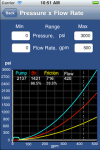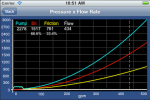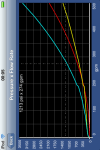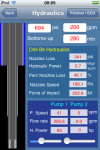Drilling Hydraulics for iPhone – improvements
Already included for the next release the percentage of losses in the drill bit and by friction in the graphic, as shown in the figures below:
Improvements requests and report of bugs can be made by email: wellcontroltech@gmail.com
Driller’s Method – formulas used in application WCMethods for iPhone, iPad and Mac
Well Control Methods for iPhone and iPod Touch – WCMethods
Description
This application uses the basic calculations of the methods to control oil wells after the occurrence of kick during drilling operations on floating platforms and land rigs.
This app is completely interactive and allows users to define a wide variety of parameters for oil wells and unit system, save data and more.
It is can be applied in the oilfield and also help on understanding the methods of the well control.
Well Control Methods:
For Simulation, use the another app “Well Control Simulation”.
For new features, report bugs, improvements and suggestions please contact us: contact@wellcontrol.com.br
Well Control Methods:
1. Driller’s Method
2. Wait and Weight
3. Dynamic Volumetric
4. Static Volumetric – Migration / Bleed
5. Static Volumetric – Lubricate / Bleed
Others:
6) calculations of Riser Safety Margin;
7) Included the formulas;
8) Ability to work with multiple files;
9) Sections: Riser, Casing, Liner and Open Hole;
10) Pop-up view to alert user about invalid values;
11) Send resume of methods by email.
12) Show graph theoretical of the methods.
13) Set drillstring with drillpipe1, drillpipe2, heavy weight, drillcollar1 and drillcollar2;
14) Select floating rig or land rig;
15) Select unit systems: Metric, SI, field1 (US Unit) and field2 (mix) or per parameter;
16) set fluid parameters: mud weight, plastic viscosity, yield point and initial gel;
17) Select rheological models: Power or Bingham;
18) Set gradients: formations and temperature;
19) Set jet nozzles or fixed TFA;
20) Vertical or Slant Well Type (KOP, TVD and Measured Depth);
21) Set surface circulation equipments (mud pump and lines);
22) Save configuration to data files;
23) Show schematic of well with drillstring;
23) Useful for filling of Standardized Kill Sheets for Well Control;
24) Useful for Filling of Previous Recorded Sheets;
25) Capacities and Volumes calculations;
26) Hydrostatic and critical pressures calculations;
27) Hydraulics calculations;
The Driller’s Method
During drilling operation of oil wells, there may be inflow of formation fluids into the well, which is an undesirable condition. The driller should detect such events and closing the well immediately. Record information after the closing of the well corresponding to stabilization of pressure, volume gain, SIDPP (Shut-in Drillpipe Pressure) and SICP (Shut-in Casing Pressure. In the case of operations on floating units (subsea stack), this term could be redefined as Shut-in Choke Pressure).
The control method to be applied is the driller’s method. That is to circulate the influx even with the original weight of the mud, keeping constant the circulation pressure named ICP – Initial Pressure Circulation. The second circulation should be made with the kill mud weight in two steps:
1. Fill the drill string until the bit by keeping the pressure at the Choke (at the KILL, on subsea stack) constant and equal to SIDPP.
2. Complete circulation of the annular to the surface keeping the pressure of circulation with the kill mud constant named FCP – Final Circulation Pressure. On subsea stack, after the choke fully open, the pump pressure increases until FCP 2.
Attention: about drill bit off bottom
This method should only be applied with the drill bit in the bottom hole or when the kick is completely in annular of the drill string. To minimize errors of calculation of the kill mud weight, the calculations made in this application considers the depth of the drill bit instead of the depth of the well to calculate the kill mud weight.
The formation pressure consider the depth of well. In case of top of the kick bellow the bit, it is recommended to apply the volumetric method until kick go through the drill bit to the annular, following then the driller’s method.
Formulas:
ICP = Pks + SIDPP
ICP = Inital Circulation Pressure, psi
Pks = Recorded pump pressure at the kill rate speed, psi
SIDPP = Shut-in Drillpipe Pressure, psi
Notes about floating units:
a) Pks must be recorded by circulating riser;
b) Record the friction loss in the choke line at the kill rate speed, psi;
KM = OM + SIDPP / (0.052 x TVD)
KM = Kill Mud Weight, ppg OM = Original Mud Weight, ppg TVD = True Vertical Depth, ft
FCP = Pks x KM / OM
FCP = Final Circulation Pressure, psi
FCP 2 = (Pks + ΔPcl) x KM / OM
FCP 2 - Final Circulation Pressure with Kill Mud at Choke, psi ΔPcl - Choke Line Friction, psi
Summary of method
| STEPS | PUMP PRESSURE | KILL PRESSURE | CHOKE PRESSURE | VOLUME TO PUMP |
|---|---|---|---|---|
| Bring the pump to kill speed | – | SICP | SICP – Choke line friction loss | – |
| Circulate out the influx to surface | ICP | – | – | Bit to Surface |
| Circulate to fill drill string with kill mud | – | SIDPP | SIDPP – Choke line friction loss | Surface to Bit |
| Circulate to fill annular with kill mud | FCP | – | – | Bit to Surface |
Formulas used in calculations of this method:
Screenshot from WCMethods:
Example in Well Control Simulator:
Screenshot from Well Control Simulator for iPhone and iPod Touch:
Wells with Surface Stack
Driller’s Method |
|
|
Wait and Weight Method (Engineer’s Method) |
|
|
Wells with Subsea Stack
Driller’s Method |
 |
Wait and Weight Method (Engineer’s Method) |
 |
Importing Data from other Apps:
Well Control Simulator iPhone | iPad |
Drilling Simulator iPhone | iPad |
Leak-Off Test Simulator iPhone | iPad |
Kick Tolerance iPhone | iPad Mac OS X |
Drilling Hydraulics iPhone | iPad Mac OS X |
Well Control Methods HD (for iPad):
Well Control Methods for Mac:
Visit our Portfolio on the App Store for more Oil & Gas apps for iPhone, iPod Touch, iPad and Mac OS X.
Visit our website for more Oil & Gas apps for iPhone, iPod Touch, iPad and Mac OS X.
Drilling Hydraulics for iPhone, iPod touch, and iPad on the iTunes
Drilling Hydraulics for iPhone, iPod touch, and iPad on the iTunes…
itunes.apple.com
Learn more, read reviews, and download Drilling Hydraulics by Cafm on the iTunes App Store.
The Drilling Hydraulics provides the driller, tool pushers, engineers, chemists, students and other professionals in the petroleum industry a productivity tool helpful in drilling of oil wells for hydraulics calculations, optimization of the penetration rate and can help on the decision on selection of bit nozzles.
Resources available:
1. Defining the parameters of the well, drill string, drill bit, mud (fluid), mud pumps, circulation lines on surface, diameter and coefficient of choke and more;
2. Options outstanding: Injecting into the drill string with the return flowline or by injecting the kill line to return the choke;
3. Options wells in floating units or in drilling land rigs;
4. Use of two mud pumps in parallel;
5. Choice of rheological models (Bingham and Power);
6. Calculations of the hydraulic drill bit and the system by friction;
7. Frictional losses in all sections, also showing the length, hydrostatic and Reynolds number in each section;
8. Calculation of the ECD on bottom hole and the casing shoe;
9. Hydrostatic calculations at the bottom hole and the casing shoe;
10. Calculation of bottoms up time;
11. Pressure x Flow chart with touchscreen and rotation (portrait / landscape) and scale definition;
12. Selecting the system of units;
13. Saves the data to reload later;
and more…
Formulas used in rheological models:
Power-law Model: API Recommended Practice 13D – Rheology and hydraulics of oil-well drilling fluids, 2009-10-05
Bingham Model: IADC Drilling Manual, eBook Version (V.11), 2000
















You must be logged in to post a comment.